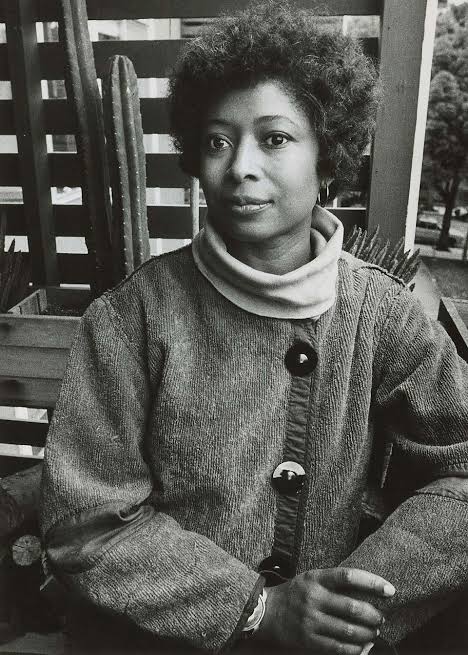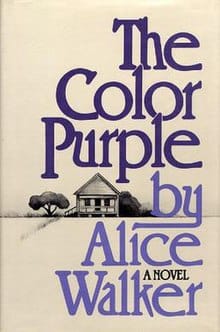Alice Walker, born on 9th February 1944, is a literary icon whose work has consistently challenged societal norms while celebrating the resilience of Black women. Among her many significant contributions to literature, The Color Purple (1982) remains her magnum opus—a novel that has not only won prestigious accolades like the Pulitzer Prize and the National Book Award but has also had a lasting impact on literature, feminist discourse, and social justice movements.

As I write this on the eve of Walker’s birthday, it is fitting to revisit The Color Purple and explore its enduring relevance. The novel is an extraordinary narrative of pain and triumph, of silence and voice, and of oppression and liberation. It is a story that continues to speak to generations of readers, offering a profound reflection on race, gender, sexuality, and spiritual growth.
A Story of Survival and Self-Discovery
At the heart of The Color Purple is Celie, an African American woman growing up in the American South in the early 20th century. The novel, written in an epistolary format, traces her life from a young age when she is sexually abused by the man, she believes to be her father. He impregnates her twice, takes her children away, and eventually forces her into a marriage with a cruel man, Mister, who treats her more like property than partner. Celie’s life is one of relentless suffering, marked by violence, silencing, and subjugation.

However, what makes Celie’s story truly remarkable is not just the hardships she endures, but the way she transforms herself from a victim into an empowered individual. The letters she writes—to God at first and later to her sister, Nettie—become a tool for self-expression, a medium through which she reclaims her voice and, ultimately, her agency.
The Power of Sisterhood
One of the novel’s most powerful themes is the significance of female relationships. Unlike traditional narratives where women are often pitted against each other, The Color Purple foregrounds the strength found in sisterhood, something that is reflective of Walker’s own feminist consciousness and belief in the power of sisterhood and community.
Celie’s deep bond with her sister, Nettie, is the emotional core of the novel. Despite being separated for years, their love remains unwavering, serving as a reminder that family, even when physically apart, can be a source of strength.
Also Read: New Beginnings: The Everlasting Power of Resilience and Growth
Equally transformative is Celie’s relationship with Shug Avery, a blues singer and the former lover of Mister. Shug is everything Celie has never been allowed to be—bold, sexually liberated, independent. Through their relationship, which evolves from friendship to romantic love, Celie learns to see herself as worthy of love and respect. Shug teaches her the joy of pleasure, the power of self-worth, and the ability to break free from oppressive structures.
Sofia, another strong female character, challenges societal expectations with her defiant personality and absolute refusal to submit to male dominance. Unlike Celie, who initially endures abuse in silence, Sofia fights back—both literally and metaphorically. Her narrative arch, which includes being imprisoned and forced into servitude for standing up to a white woman, underscores the double oppression Black women face: racial and gender-based. Despite her suffering, Sofia’s resilience and eventual reconciliation with her family highlight the importance of perseverance.
Race, Gender, and the Intersection of Oppressions
The novel portrays the compounded struggles of Black women who not only experience racial discrimination from white society but also gender oppression within their own communities.
Walker masterfully interweaves themes of racism, sexism, and economic hardship in The Color Purple.
Mister’s treatment of Celie reflects the patriarchal structures deeply ingrained in society. Black women, expected to be obedient and subservient, are often denied autonomy over their own bodies and choices. Celie’s journey of self-discovery is, therefore, a radical act of defiance against these oppressive forces.
The novel also critiques colonialism and its impact on African societies through Nettie’s experiences as a missionary in Africa. Nettie’s letters detail the erasure of African traditions due to European influence, drawing a parallel to the ways Black identity is suppressed in America. This broader perspective reinforces Walker’s exploration of systemic oppression beyond individual experiences.
Spirituality and the Redefinition of God
A striking aspect of The Color Purple is its spiritual journey. At the beginning of the novel, Celie’s understanding of God is shaped by the religious teachings imposed on her—God is a distant, white, patriarchal figure. However, as she grows, influenced by Shug’s more expansive spirituality, she comes to see God as a force present in nature, love, and human connections.
This transformation signifies Celie’s liberation from not just societal oppression but also rigid religious doctrines that reinforce submission. By redefining God on her own terms, she embraces a spirituality that empowers rather than confines her.
Legacy and Cultural Impact
Since its publication, The Color Purple has transcended literature to become a cultural phenomenon. The novel was adapted into an Oscar-nominated film directed by Steven Spielberg in 1985, starring Whoopi Goldberg as Celie, Oprah Winfrey as Sofia, and Margaret Avery as Shug Avery. Despite its critical acclaim, the film was also met with controversy, particularly from some members of the Black community who felt it portrayed Black men in an overly negative light.

In 2005, the novel was transformed into a Broadway musical, which won the Tony Award for Best Revival of a Musical in 2016. In 2023, a new film adaptation based on the musical was released, reaffirming the story’s timeless relevance.
Beyond adaptations, The Color Purple has influenced contemporary discussions on feminism, intersectionality, and LGBTQ+ representation. Walker’s portrayal of Black female queerness was groundbreaking at the time and continues to inspire discourse on sexuality and identity.
Alice Walker’s Enduring Influence
Walker’s literary career extends far beyond The Color Purple. She has been a lifelong activist, advocating for civil rights, gender equality, and social justice. Her other works, including Meridian (1976) and Possessing the Secret of Joy (1992), continue to explore themes of oppression and resistance.
However, it is The Color Purple that remains her most celebrated work, a novel that speaks to the power of transformation. Walker’s depiction of Celie’s journey from oppression to self-fulfilment serves as an enduring symbol of resilience and hope.

As we celebrate Alice Walker’s birthday, revisiting The Color Purple reminds us why it remains a cornerstone of American literature. It is a novel about pain but also about joy, about oppression but also about resistance, about silence but also about voice. It is a testament to the indomitable spirit of Black women, to the healing power of love and friendship, and to the ultimate triumph of self-discovery.
Walker’s masterpiece continues to resonate, offering a beacon of hope to all who dare to imagine a life beyond the constraints imposed upon them. Through The Color Purple, Alice Walker has gifted the world a story that is not just to be read, but to be felt, lived, and remembered.
Image Courtesy: Wikipedia, The Nation, UGA Today, Golden Globes
An Assistant Professor of English and an internationally awarded debater and writer, Ayushee finds her creative conduit in public speaking and writing. Her areas of interest include Cultural Studies, Greek Mythology, Eco-feminism, and Literature of the Subaltern. She rejuvenates by spending time in nature and reading.








